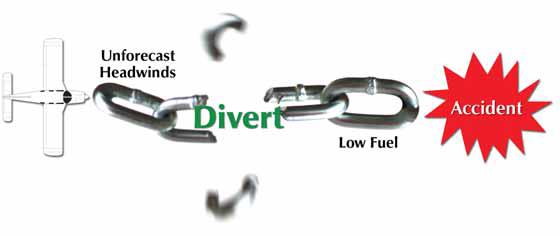Go or No Go
Safety Spotlight: Do the Right Thing

On the Ground
It may seem obvious, but some of the best aeronautical decisions are made on the ground. A prudent preflight choice can eliminate the need to make a much more difficult in-flight decision.
Such choices are easy to make when conditions are obviously poor, or obviously good. In the real world, though, the situation is often less clear-cut. When conditions are marginal, external pressures have a better chance of influencing the go/no-go decision. Time, money, emotions, personal commitments, and professional obligations can be powerful motivators. Even the most safety-conscious pilot can find it extremely difficult to “just say no” to a flight, particularly when getting there is important and conditions don’t clearly argue for staying on the ground.
The best way to avoid temptation is to prepare a contingency plan. General aviation aircraft can be superb traveling machines, but if you absolutely must be there on time, be prepared to drive, or buy an airline ticket.
Real Pilot Story: From Miscue to Rescue
Learn from a pilot’s poor decisions and a lack of preparation, which turned a four-hour cross-country flight into a 30-hour survival crisis for him and his family.
In the Air
You should enter a continuous decision making cycle. Take the knowledge and information you already have, combine it with the new information you’re gathering as you fly, and actively decide how to proceed.
The active decision making process can be broken down into three basic steps: Anticipate, Recognize, and Act.
Anticipate: What could go wrong?
It’s a good idea to maintain an active mental “lookout” for potential problems before and during flight. But also recognize that different phases of flight call for different degrees of anticipation. For example, think about the takeoff and initial climb to cruise. Have you actively considered the possibility of an engine failure on takeoff and thought about the required response? In this case, you must recognize the problem immediately and be spring-loaded to take action. On the other hand, an engine failure over open countryside, at altitude, affords considerably more time to troubleshoot and decide on the best options for a successful outcome.
Recognize: Has something gone wrong?
Avoid problems in flight by paying attention! The sooner you recognize a problem and start thinking about how to handle it, the better.
Some problems are obvious. A broken crankshaft will make itself known immediately. But smaller, more insidious problems can be difficult to detect if you’re not paying close attention. For example, deviations from the weather forecast can be quite subtle, and trouble with the aircraft—such as a failing electrical system—can easily be overlooked.
The key is to stay alert and look for things that don’t seem normal, or don’t fit with expectations. Pay attention to anything that gives you “cause to pause.” These are signals that the situation is changing—possibly for the worse—and that you may need to take action.
Act: Evaluate your options and choose one.
Here’s where many pilots fail. They recognize the problem, but don’t do anything to confront it. Why? It’s inconvenient. It means a major change in plans, and it may mean making a difficult or unpleasant choice. Regardless, once you’ve recognized a problem there is a choice to be made. That choice depends upon a number of factors—the type and seriousness of the problem, the rate at which the situation is deteriorating, and the available alternatives. Be prepared to act without delay, should the situation warrant it.

Accident Case Study: Emergency Management
Pilots sometimes tend to enter a state of denial when faced with a problem. This video draws lessons from a pilot’s unfortunate decisions during a vacuum pump failure in instrument meteorological conditions.
Priorities
Suppose that you’re faced with a critical decision. The absolute, number one priority should be getting on the ground alive and unharmed. In some cases, that might mean making a precautionary off-airport landing, even if it involves damaging or destroying the aircraft. Use ALL the resources at your disposal—ATC, flight service, other pilots (including those on the radio), passengers, etc. Don’t hesitate to declare an emergency if you’re in trouble. ATC has many resources, and may be able to assist in a number of ways. Don’t believe the old myth that declaring an emergency means filling out reams of paperwork or attracting unwanted attention from the FAA. That’s simply not the case—even if the FAA takes a special interest in your situation, it’s not worth the extra risk just to avoid meeting with an inspector.
The really tough decisions usually don’t “sneak up” on us. They arise because we either fail to recognize a problem soon enough, or fail to take action while there are still viable alternatives.Options
At the risk of oversimplifying, the basic options available when a problem arises are as follows:
- Continue the flight as planned, paying very close attention to whatever is causing the problem.
- Continue the flight, deviating from the plan as necessary.
- Get the airplane on the ground as soon as practical.
The more serious the problem—or the more limited your understanding of its seriousness—the more conservative the choice should be, and the more you should lean toward a precautionary landing.

A timely choice provides many more alternatives. In a rapidly deteriorating situation, every passing minute robs you of options—options that likely won’t come back. Remember: The really tough decisions usually don’t “sneak up” on us. They arise because we either fail to recognize a problem soon enough, or fail to take action while there are still viable alternatives.
Accident Case Study: Final Approach
The airplane collided with trees during an emergency approach due to fuel exhaustion. Learn why it became the final link in a long chain of mistakes and missed opportunities.